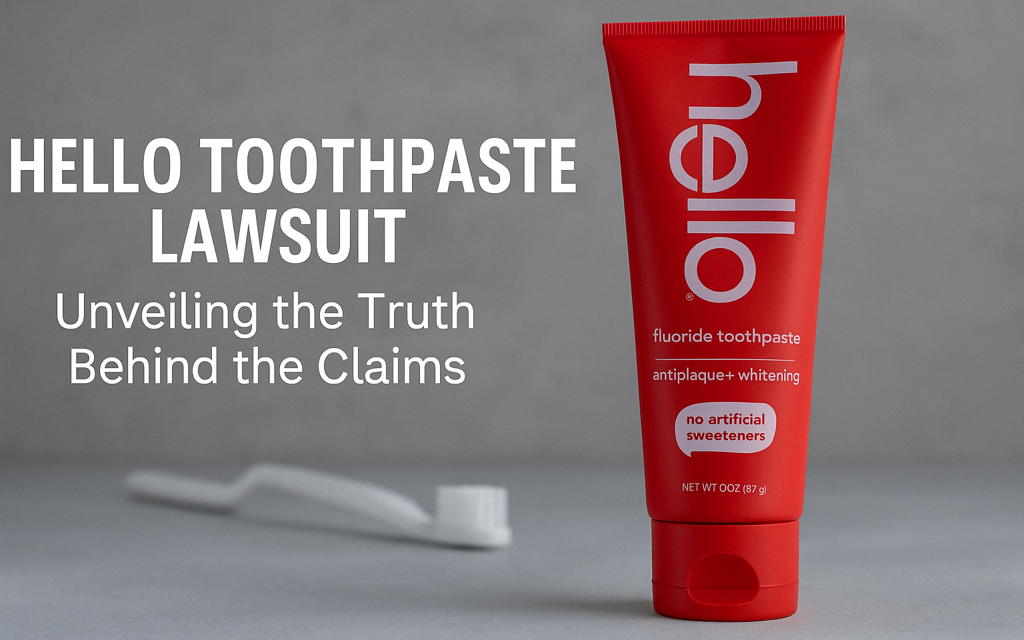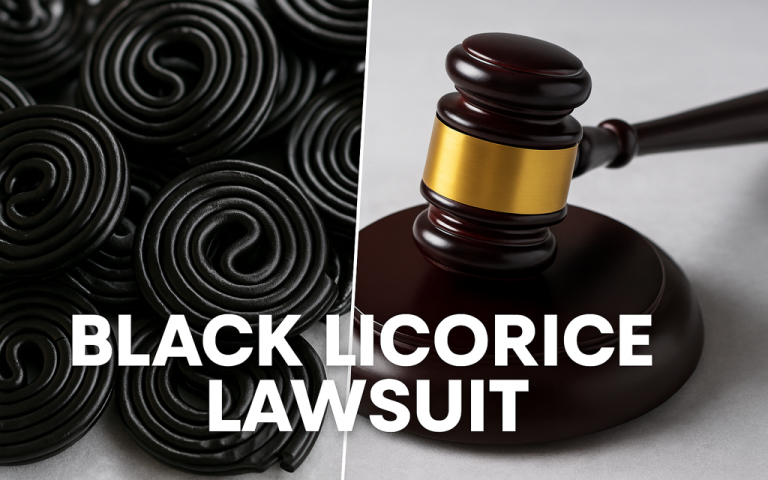The Hello Toothpaste Lawsuit shocked many health-conscious consumers. It exposed serious concerns about ingredient labeling. People trusted Hello Products for clean, safe, and honest toothpaste. That trust has now come under fire.
The issue began when buyers discovered that so-called “natural” toothpaste contained highly processed ingredients. These synthetic compounds, like sorbitol and xylitol, stirred legal and public backlash. The case quickly escalated into a class action.
The lawsuit revealed gaps between marketing claims and reality. It ignited a larger conversation. People now question how companies use health-focused language. This legal battle marks a shift in how consumers evaluate personal care brands
Why Hello Products Came Under Fire
Hello products built a brand on health and purity. Their marketing focused on being clean, sustainable, and honest. Their packaging prominently displayed claims that suggested authenticity:
- “No artificial sweeteners”: This led customers to assume the toothpaste contained only natural ingredients. Buyers relied on this promise, especially those avoiding synthetic chemicals.
- “Naturally friendly ingredients”: The phrase implies that ingredients are minimally processed and safe. Parents and health-conscious users were drawn to this type of labeling.
- “Thoughtfully formulated for wellness”: This built trust by suggesting the company carefully selected ingredients with consumer health in mind.
Despite this messaging, the product includes sweeteners that undergo synthetic chemical transformations:
- Sorbitol: A sugar alcohol created through industrial hydrogenation. Although sourced from natural glucose, the end product is synthetic.
- Xylitol: Extracted from plant materials but refined using chemicals. The compound’s final form does not align with expectations of “natural.”
The contrast between clean branding and processed contents led to consumer outrage and legal action.
Major Events in the Lawsuit’s Timeline
The Hello Toothpaste lawsuit did not emerge overnight. Each event built momentum, driving more scrutiny and legal traction. Here’s how it unfolded:
- December 2023 – Lawsuit Filed: The case began when Norah Flaherty filed a formal complaint in California. She accused Hello Products of false advertising. Her claim centered around the “no artificial sweeteners” label, which she believed was misleading. Her legal team cited specific ingredient data and consumer protection laws.
- January 2024 – Class Action Formation: More consumers stepped forward. Their shared experiences added weight to the case. As the plaintiff pool grew, the lawsuit transitioned into a class action. This change allowed broader participation and reflected rising public concern.
- March 2024 – Expert Opinions Released: Legal teams submitted scientific reviews from chemists and food scientists. These experts explained how ingredients like sorbitol and xylitol are chemically processed. Despite being derived from nature, their production involved synthetic modifications. These testimonies solidified claims that the ingredients were not as “natural” as marketed.
- May 2024 – Corporate Response Issued: Hello Products responded through a press statement. They claimed full compliance with FDA standards. However, they did not address the deeper issue of misleading language. The response sparked further criticism. Consumers wanted transparency, not deflection.
- January to March 2025 – Social Media Awareness Surge: Activists and influencers amplified the lawsuit across social platforms. Hashtags like #HelloLawsuit and #CleanLabelTruth trended. YouTube reviews, TikTok breakdowns, and Instagram posts dissected ingredients and packaging claims. The online backlash became a key force in maintaining public pressure.
Each phase revealed growing awareness. What started as a single claim turned into a national consumer movement.
What the Lawsuit Says
The legal claims against Hello Products focus on consumer protection. Plaintiffs believe the company used deceptive language to increase sales:
- Deceptive advertising: Hello said the product contained “no artificial sweeteners.” But the presence of chemically modified ingredients contradicts that promise.
- False claims: Ingredient processing steps, when fully examined, do not align with natural or clean-label standards.
- Consumer harm: People paid a premium. They chose the product for its supposed purity. If they knew the truth, they would have chosen differently.
- Breach of trust: Customers expect companies to label products honestly. This breach erodes trust and damages brand loyalty.
These claims fall under several state and federal consumer protection laws.
Understanding Sorbitol and Xylitol
These two sweeteners are at the heart of the lawsuit. Their use raised the biggest concerns. Here’s how they are processed:
Sorbitol
- Made from glucose: Manufacturers convert corn syrup into sorbitol through hydrogenation.
- Acts as a humectant: It helps retain moisture in toothpaste and prevents it from drying.
- Taste enhancer: Sorbitol gives a sweet taste without the use of sugar.
- Lab-engineered: Despite its natural origin, it becomes synthetic through chemical treatment.
Xylitol
- Sourced from corn cobs or hardwood: The natural materials are broken down into xylan.
- Converted through hydrolysis: This step uses acid or enzymes to release xylose.
- Purified into xylitol: Industrial steps complete the transformation into a refined sweetener.
- Marketed for dental health: It is often said to fight cavities, but it remains synthetically produced.
Consumers did not expect these types of ingredients in a product labeled “natural.”
Brand Image vs. Reality
Hello Products invested heavily in branding. Their design and language aimed to reassure customers:
- Earthy colors and clean fonts: These visual elements evoke feelings of calm, safety, and health.
- Plant-based visuals: The use of leaves and natural symbols reinforces the message of organic purity.
- Buzzwords like ‘friendly’ and ‘clean’: These words lack clear legal definitions. Companies use them freely.
- Contradictory ingredient list: The inclusion of synthetic compounds directly clashes with the image they project.
This contradiction led critics to accuse Hello of greenwashing. The term describes when companies mislead buyers about their eco-friendliness.
What the Law Says About Misleading Labels
Multiple laws protect buyers from dishonest labeling. The Hello case involves several important legal concepts:
- False advertising: Labels must accurately describe what’s inside. If the words are misleading, the company may be liable.
- Unfair competition: Brands that use honesty lose sales to misleading competitors. This distorts the market.
- Breach of warranty: Claims on packaging are seen as promises. If those promises fail, it’s a legal violation.
These laws aim to balance the power between consumers and corporations. Courts can fine companies, force recalls, or demand changes to packaging.
How the Public Responded
Buyers did not stay silent. They shared their experiences and concerns online:
- Personal stories flooded social media: Users described how they trusted the brand and felt betrayed.
- Negative reviews increased: People left one-star ratings and demanded transparency.
- Consumer watchdogs issued warnings: Non-profits and health websites flagged Hello as a brand to watch.
- People switched products: Buyers began using toothpaste brands with certified natural ingredients.
Influencers played a key role. Many created posts breaking down the lawsuit and ingredient lists. They educated followers about synthetic compounds and clean alternatives.
This Lawsuit Affects All Clean-Label Brands
The ripple effect extends beyond Hello. It challenges the entire wellness and clean-label industry:
- Brands will face tougher label checks: Regulators may soon demand proof behind every “natural” or “clean” claim.
- More lawsuits may follow: Consumers now understand their rights. Legal action could rise across multiple sectors.
- Companies must prove every claim: Vague language is no longer enough. Detailed proof and certifications are needed.
- Transparency will become essential: Brands must share where ingredients come from and how they’re processed.
The lawsuit set a new bar. It encourages a deeper look at how products are formulated and advertised
How to Join the Class Action Lawsuit
If you feel misled, you may be eligible to participate in the class action. Here’s how to get involved:
Check Your Purchase History
- Find proof of purchase: Receipts, email confirmations, or bank statements will help validate your claim.
- Timeframe matters: You must have bought Hello Toothpaste between 2020 and 2024.
Understand Your Eligibility
- Label-dependent purchase: You must have bought the product specifically because of its “no artificial sweeteners” claim.
- Location counts: The lawsuit is based in the United States. International buyers may not qualify.
File Your Claim
- Visit class action websites: TopClassActions.com and ClassAction.org offer forms to register.
- Follow the instructions: Submit all required documents to support your claim.
- Stay updated: Sign up for alerts to track the lawsuit’s progress.
Taking action helps strengthen consumer rights. Even a small claim can make a big differences.
Where Hello Products Stand Today
Hello Products still sells its toothpaste. But the brand faces major challenges:
- Sales have dropped: Health-conscious stores reported reduced interest and lower shelf rotation.
- Negative reviews increased: Online platforms show growing dissatisfaction among regular users.
- Retailers responded cautiously: Some moved Hello toothpaste to less visible spots or added disclaimers.
- Public sentiment shifted: Trust in the brand declined. Many buyers won’t return unless transparency improves.
So far, Hello Products has not issued a recall or reformulated its products. Their silence has fueled further consumer frustration.
Lessons from the Hello Toothpaste Lawsuit
This legal case offers important lessons for both companies and consumers:
- Always read the full label: Don’t rely on front-facing claims alone. The ingredients list tells the full story.
- Avoid buzzwords: Terms like “clean,” “friendly,” or “natural” can be misleading. Ask what they actually mean.
- Look for third-party certifications: Seals from USDA Organic or EWG Verified give added trust.
- Support transparent brands: Choose companies that publish sourcing, processing, and formulation details.
Smart consumers drive change. Their choices push the market toward honesty and integrity.
Conclusion: What the Hello Toothpaste Lawsuit Really Means
The Hello Toothpaste Lawsuit changed how we view clean-label products. It exposed flaws in brand claims. It reminded us that trust must be earned. Consumers will no longer settle for vague promises. They want proof. They want honesty. This lawsuit might spark a new era of transparency. If you’ve bought Hello Products, learn your rights. If you care about clean products, demand the truth. Let this lawsuit remind every company: the label must match the product.
Frequently Asked Questions (FAQs)
What is the Hello Toothpaste Lawsuit about?
The lawsuit accuses Hello Products of falsely advertising their toothpaste. The claim focuses on the phrase “no artificial sweeteners.” Consumers argue that ingredients like sorbitol and xylitol, which are chemically processed, contradict that label.
Is this a class action lawsuit?
Yes. After the initial filing in December 2023, the case expanded into a class action in January 2024. This allows multiple people with similar complaints to seek justice as a group.
Are sorbitol and xylitol harmful?
These ingredients are not dangerous for most users. The issue lies in how they’re marketed. Both compounds undergo synthetic processing. Their presence in “natural” products may mislead customers, especially those avoiding lab-altered substances.
Can I join the class action lawsuit?
You may qualify if you:
- Purchased Hello Toothpaste between 2020 and 2024.
- Did so because of the “no artificial sweeteners” claim.
- Have proof of purchase like receipts or bank records.
- Live in the United States.
Where do I file my claim?
You can file through class action legal websites. The most reliable include:
These platforms offer form submissions and legal updates.
Has Hello Products changed their formula or labeling?
As of April 2025, no formula changes or labeling updates have been confirmed. The company continues to sell the same products. Many consumers see this as a missed opportunity to rebuild trust.
What happens if the plaintiffs win?
If the court rules in favor of consumers, Hello may need to:
- Pay financial settlements to affected buyers.
- Update packaging and ingredient disclosures.
- Improve clarity in future advertising.
How long will the case take to resolve?
Class action lawsuits can last from several months to a few years. Timelines depend on the complexity of claims, evidence reviews, and court scheduling.
Why does this case matter to other brands?
The outcome could redefine marketing standards in health and wellness industries. It warns brands not to exaggerate. It also empowers consumers to challenge false claims more confidently.




